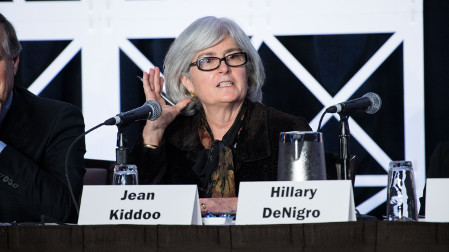APTS Members Get Crash Course on Repack, ATSC 3.0
WASHINGTON—PBS stations and other local public channels like it provide many educational services/programs through their stations, but Wednesday afternoon they got a crash course in some of the biggest issues set to face the industry over the next few years. At the 2017 Public Media Summit in Washington, general managers from public stations across the country gathered to listen to industry leaders and FCC staffers about the upcoming plans for both the TV spectrum repack and the transition to the ATSC 3.0 next-generation standard.
The General Managers Session began with a recorded message from new FCC Chairman Ajit Pai, who set the table with the claim that the TV Spectrum Incentive Auction was a success and how ATSC 3.0 is the next big technology for the industry. But the meat and potatoes of the session came after the chairman wrapped up his speech.

John McCoskey
John McCoskey, industry lead executive for communications, media and technology at Eagle Hill Consulting, presented a slide show that helped detail the road ahead for public broadcasters with both the spectrum repack and the transition to ATSC 3.0. McCoskey did not mince words when he said that the repack was likely going to be a pain for many broadcasters with an estimated 1,300 stations needed to be repacked, the need for new antenna systems and a first 90 days that will be critical for stations to get things in order to make sure they will be able to meet the 39-month deadline set forth by the FCC; he also voiced a concern about the large number of rural states that have a lot of transmitters, saying it is “going to be a particularly challenging part of this repacking for public television and I don’t think we fully understand the impact of that yet.”
However, he believes the silver lining of the repack will be the acceleration and introduction of the ATSC 3.0 standard. He highlighted for attendees many of the features that the next-gen standard plans to offer, including UHD and HDR technology, IP-based services and increased transmitter power. He cited industry experts who believe that the full transition to the new standard could take between five and 10 years, but he stressed how it will be worth it. “It’s not an incremental change,” McCoskey explained, “it’s really a fundamental change in the way broadcasting works and it’s also very future aware.”
After McCoskey’s presentation a panel of FCC staffers took the stage to provide the commission’s perspective on what will happen in the coming months regarding the spectrum repack. The panel included Michelle Carey, acting chief of the Media Bureau; Hillary DeNigro, associate chief of the Media Bureau; Gary Epstein, chair of the Incentive Auction Task Force; and Jean Kiddoo, deputy chair of the Incentive Auction Task Force.
Epstein began his portion of the panel echoing chairman Pai’s sentiments that the auction was a success, but he also went into more detail about the next step in the process—the assignment phase. While no official date has been confirmed, Epstein said that broadcasters can expect to see a release of a public notice in April that will mark the beginning of the 39-month repack. Epstein also commented how he knows that the auction was not a penicillin for all public stations, with some stations choosing to drop out of the auction or not participate at all, but that this was always a consideration that was prepared for in the auction design.
Get the TV Tech Newsletter
The professional video industry's #1 source for news, trends and product and tech information. Sign up below.

Jean Kiddoo
Deputy Chief Kiddoo followed up Epstein by highlighting the steps stations can now take in preparation for the transition. One of the efforts from the FCC to do so was the waiving of the prohibitive communication rule between stations that participated in the auction, which with letters Kiddoo said the FCC sent out to stations being repacked on their post-auction channel and phase assigments, allows them to get a head start on relocation and planning. The commission also released its transitioning scheduling plan back in January, highlighting the 10-step process of when specific stations are expected to complete their transitions.
“We understand the transition is a major undertaking and that stations are differently situated,” DeNigro followed. “We developed procedures to address the major categories and within those requirements we built in some flexibilities as support stations have individual issues.” These often include waivers for stations in regards to things like construction permits and other specific filing windows; though DeNigro stressed that these waivers to not remove the deadline stations must meet in completing the transition.
Media Bureau Acting Chief Carey wrapped up the panel with the commission’s take on the ATSC 3.0 standard. “Although we’re very anxious at the commission to facilitate innovation and enable adoption of this voluntary standard, at the same time we must be mindful of the affect that this new technology will have on consumers,” she explained. This is why, she claimed, that the recently released Notice of Proposed Rulemaking included questions about technical and consumer aspects of the technology as the commission will continue to educate viewers on the standard.
For more TV Technology coverage, see our ATSC 3.0 silo.
